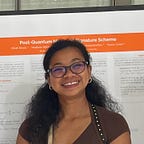Initiating Online Conversations: Cold Email Best Practices Demystified
So, you have to write a message to a person you never met before. You may be asking yourself:
“What am I going to say? How should I start? Will they even answer me?”
You are not alone, I’ve crafted plenty of cold emails. Let me demystify this topic for you!
What is cold emailing?
A cold email is an unsolicited e-mail (can also be a Social media DM) that is sent to a receiver without prior contact. (Wikipedia)
Will people even read a cold email (DM)?
Yes, if it’s good and relevant to them! So, nail your message quality!
What make a quality cold email?
Professional email address/pseudo, profile picture and subject line
Those are the first things your receiver see. For DMs, the opening sentence is the equivalent of the subject line.
If you have a school email, use it! But even if you don’t, you can still follow these easy steps to create a professional email address:
- Use your real name, ex: antsafandresena@email.com (not my email address!)
- Avoid numbers, antsafandresena134@email.com is a no!
- If the email address you like is taken and Google suggest you use numbers, try a variation ex: antsafandresenar@email.com or antsatfandresena@email.com (also, not mine)
For each of your accounts, choose a profile picture that that resonate positively with a wide audience — no controversial vibes!
- Consider outfits that won’t raise eyebrows or offend anyone. No revealing clothes in profile pictures! They may distract your reader from your message!
- You can display your company’s logo, or your school’s emblem. I used a picture of a roaring tiger on my Facebook.
- I would recommend showcasing something unique about yourself in your profile picture,
The subject line should be short, concise and tell what you want to talk about.
- Don’t say, “Can you help me, please?”. It is not clear! You can use “Interested in your tutoring service” or “Questions about AIMS”!
- Make every word count. Use simple phrases. Acronyms are welcome if the reader will understand it!
Ex: don’t say, “I have questions about the Masters program at the African Institute of Mathematical Sciences in South Africa”! (too long!), “Questions about AIMS SA” is far better!
Avoid spammy subject lines:
- DON’T USE UPPER CASE LETTERS! They’re scary.
- Don’t say, “Urgent help needed”.
- Limit special characters.
Make the email/DM personal
Don’t write, “Dear Madam”, use “Hello Antsa”. Make sure you spell the name right! There is no bigger repellant than receiving a message with the wrong name! Share a little context. Acknowledge something you admire about them.
Ex: “Hey Antsa. I came across your comments on Vanessa’s post. I really appreciate your testimonial. I want to know more about the Masters program at AIMS.”
You can also talk about their research, talks or contributions.
Ex: “I attend your talk at the AWM conference this afternoon. I wanna know more about the topic of Black Girls in Math. Can we arrange a meeting to talk about it?”
Tell who you are in a way that is relevant to the topic of your request.
If you write to a college professor, don’t say: “My name is Antsa, I am from Madagascar. I have a brother and a sister. I always dreamed of attending a prestigious school one day but I did not pass the entrance test….” (irrelevant!)
Instead use: “I am Antsa, I got a bachelor’s degree from the university of Antananarivo, Madagascar. I would like to join the Ph.D. program at University Clemson. I saw your profile and read some of your articles. Could you tell me how many people are working in a similar field at Clemson?”
If you are requesting for funding on your movie project, don’t say “I am studying at the University of Antananarivo”, say “I directed the movie ‘Gatos sin Dientes’ ”.
Be precise in your request
Don’t say “Can you help me with my language learning?”.
Instead, write “I want to practice English but I don’t have money to attend a class. Do you have some recommendations for budget-friendly materials?”
Highlight your relevant experiences. Describe your plan if they accept your request. Explain why is this request important for you.
Use Who, What, When, Why, How questions to brainstorm your content!
Include all relevant documents in the email
Yes, in the first email!
If I send an email to a cryptography professor, I will write, “I did my Masters thesis (see AntsaMastersThesis.pdf attached) in code-based cryptography.”
Attach that transcript, that spreadsheet, that thesis, …. Use an universally readable format (docs, pdf,…). Make sure all your files are named explicitly. Ex: “AntsaCV.pdf” beats “AllAcademicDocs.pdf” and “AntsaCVfinalfinal.pdf”. Make the task of reading your message easy! Avoid sending a file that needs a special software!
Your message may sit there for weeks before they’ll read it! But when they open it, it’s easy for them to also open the attachments!
Use spell check
I use Grammarly, Reverso and Scribens. I also check my readability using https://hemingwayapp.com/! These services comes with free tiers!
Don’t send it right away
Start writing early! Give yourself time to refine your work! After the initial draft, wait a few hours before editing! Always proofread! Make each sentence strong and short.
Ex: Instead of “My name is Antsa”, use “I am Antsa”.
Have someone read your email and give you feedback!
Listening and accepting feedback on your writing is uncomfortable! Even for me! But, feedback turns rough drafts into masterpieces! Seek a person that can give you honest advice and know their way around email writing! Ask your advisor, a friend, a family member.
Only follow up once!
Give people at least a week before sending a gentle follow-up. If they do not reply after the second message, stop sending them messages. Unless you want to be blocked.
If you like these pieces of advice, share with your friends and give me a clap!
Antsa
